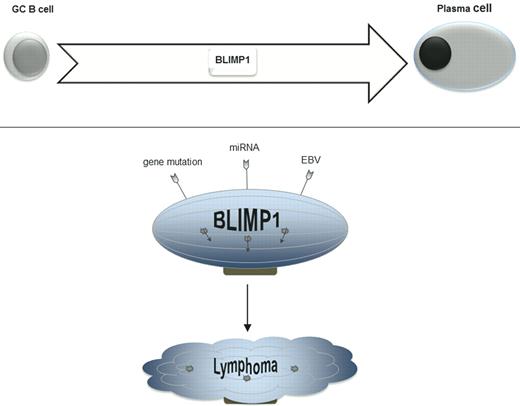In this issue of Blood, Vrzalikova et al present evidence that Epstein-Barr virus (EBV) infection leads to the down-regulation of BLIMP1α in primary germinal center (GC) B cells.1 BLIMP1 is a transcription factor encoded by the PRDM1 gene. It stops cell cycling and leads to terminal differentiation of B cells to plasma cells. The authors suggest that EBV inhibition of BLIMP1α expression serves to inhibit terminal differentiation of EBV-infected cells.
From the viral perspective, inhibiting the terminal differentiation of EBV-infected lymphocytes ensures the stability of the reservoir of latently infected B cells. Studies of EBV gene expression in blood and tonsils show 2 distinct forms of viral genome replication: host-driven replication commonly referred to as latency replication, and virus-driven replication commonly referred to as lytic replication. In latency or host-driven replication, cell division is preceded by replication of cellular and viral genomes (present as nuclear plasmids). The cellular DNA polymerase replicates the viral genome. Cellular and viral genomes are partitioned into daughter cells. Replication of the viral genome does not involve virion production or viral enzymes. Expression of viral gene products that might trigger an immune response is minimized. In virus-driven replication, cell division does not occur. Replication of the viral genome involves the viral DNA polymerase and other viral enzymes. Replicated genomes are packaged into virions. Whereas latency viral gene expression is readily detected in memory B cells from healthy individuals,2 lytic gene expression is mainly detected in plasma cells.3,4 Host-driven viral replication in memory B cells serves to increase the numbers of virus-infected B cells without expression of many viral enzymes, transcription factors, and capsid components and thus allows the virus to elude immune surveillance. By inhibiting the terminal differentiation of EBV-infected B cells to plasma cells, inhibition of BLIMP1α preserves the ability of the virus to fly under the radar. Plasma cell differentiation, on the other hand, signals an end to such passive replication. BLIMP1 and XBP1(s) lead to plasma cell differentiation and, in parallel, trip the viral regulatory switch to viral-driven lytic replication.3,4 Thus when viral gene expression is detected in plasma cells, lytic viral genes are being expressed.
BLIMP1 gene expression is important in the transition from B cell to terminally differentiated plasma cell. Evidence is emerging that BLIMP1 tumor suppressor functions may be disrupted by inactivating mutations, microRNA expression, or by EBV LMP1 gene expression.
BLIMP1 gene expression is important in the transition from B cell to terminally differentiated plasma cell. Evidence is emerging that BLIMP1 tumor suppressor functions may be disrupted by inactivating mutations, microRNA expression, or by EBV LMP1 gene expression.
Vrzalikova and colleagues suggest that BLIMP1α inhibition is the result of the EBV latency membrane protein 1 (LMP1). LMP1 is a member of the tumor necrosis factor receptor (TNFR) superfamily and modulates cellular gene expression in many ways. Many of the LMP1 effects on cellular gene expression parallel those of BLIMP1α. However, some genes are differentially affected. BLIMP1, but not LMP1, suppresses genes that are required for plasma cell differentiation: BCL2A1, CIITA and MYC. As a result, LMP1 down regulation of BLIMP-1α expression diminishes the likelihood that the memory B cell will terminally differentiate into a plasma cell leading to viral lytic replication (“going viral”). This is consistent with a previous report that EBV infection of plasma cell lines leads to partial reversion to a B-cell phenotype.5
In addition to providing insights into the EBV–B cell interaction, these investigations may also shed light on lymphomagenesis (seefigure). The inability to exit cell cycle and terminally differentiate is a step along the path to malignancy. PRDM1 inactivating mutations have been identified in some diffuse large B-cell lymphomas6,7 and translational inhibition by cellular microRNA in others.8 Thus PRDM1/BLIMP1 has been identified as a tumor suppressor.9 Vrzalikova et al suggest that in diffuse large B cell lymphoma that harbor EBV, viral gene expression may contribute to lymphomagenesis by down-regulating BLIMP1.
Conflict-of-interest disclosure: The authors declare no competing financial interests. ■
REFERENCES
National Institutes of Health


This feature is available to Subscribers Only
Sign In or Create an Account Close Modal